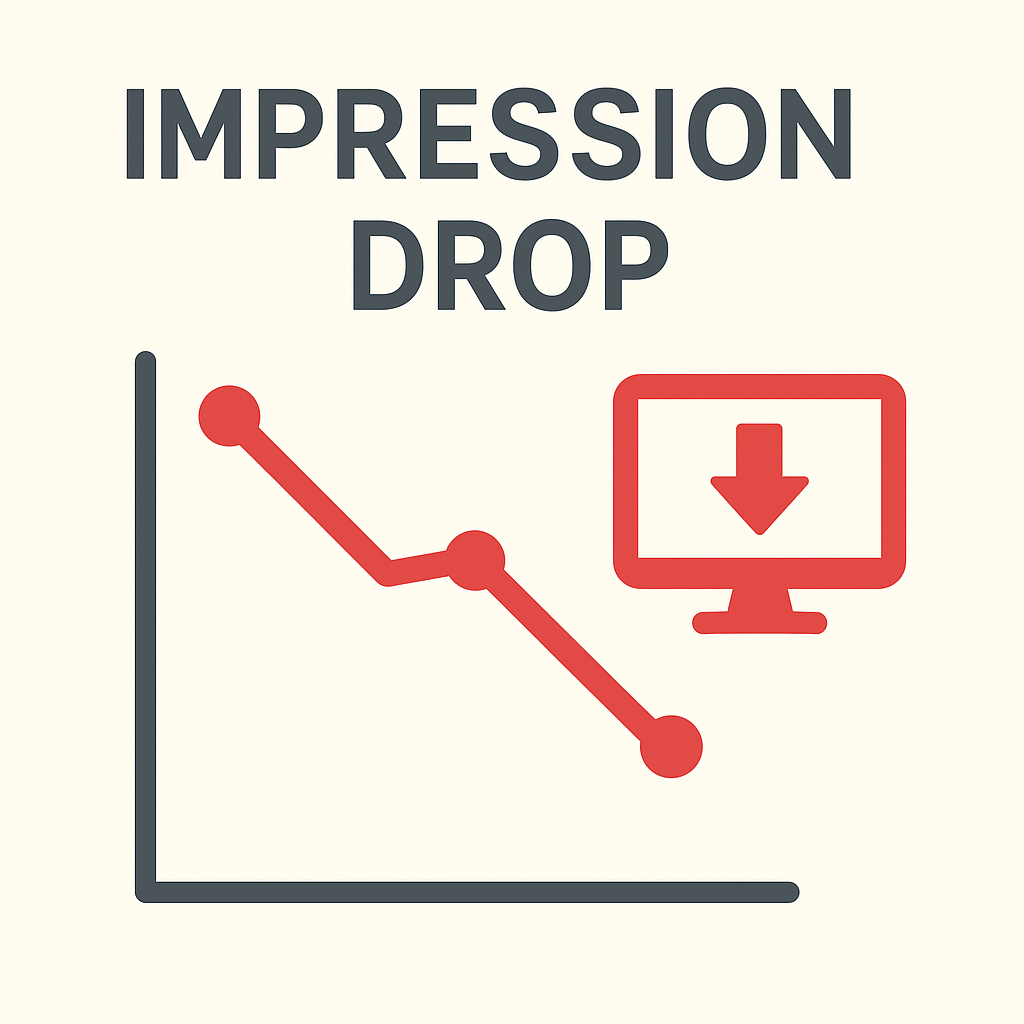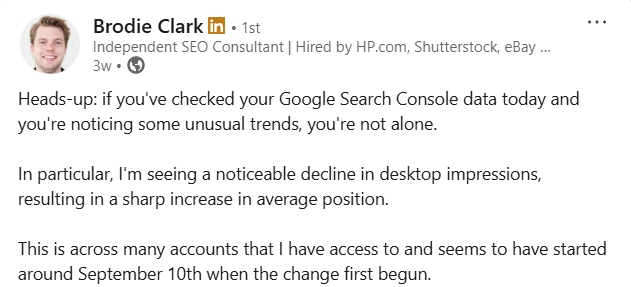Why Are Impressions Dropping in Google Search Console?

To put it simply, especially for businesses running SEO Sydney campaigns who noticed sudden reporting changes, you are often looking at a shift in measurement of impressions rather than an abrupt drop in actual impressions.
Google made changes to the way some search results are shown and tallied as of mid-September 2025. This modification eliminated a long-standing method that allowed scrapers and third-party programs to request 100 results at once.
Even when clicks and actual traffic remain constant, the outcome is a significant and abrupt decline in reported impressions for all websites

What’s Actually Happening Behind the Drop
The undocumented results per page option, which let 100 results to appear on a single page, was no longer supported by Google. That behavior was leveraged by several rank trackers and scraping applications to swiftly gather a lot of SERP data. In Google Search Console, the automated queries were recorded as impressions when they resulted in the same pages being displayed. The phantom impressions disappeared from GSC reports when that channel was stopped, and impressions for the majority of properties dropped precipitously. Right present, this is the primary technical cause of Google Search Console impressions being lost between dashboards.
Why You Don’t Need to Panic
This is a reporting change rather than a business issue if your business metrics, like organic sessions, inquiries, bookings, or revenue have not decreased in analytics or your CRM. While clicks and conversions are constant, many teams experience a significant decline in Search Console impressions. To determine whether actual visibility has changed, use consistent traffic and conversion signals. Speak with an SEO Consultant who will evaluate the statistics to actual conversions.
How this change impacts rank trackers and keyword measurement
Rank trackers rely on their ability to read a large number of results fast. With that capacity reduced, trackers are now missing many of the deep page locations they previously captured. Short-term effects for tools include slower data collecting, fewer low-ranking keyword reports, gaps in historical comparisons, and more costs for providers who must utilize more courteous paginated checks. That alters how keyword performance appears, but it does not imply that your site is suddenly invisible to genuine searchers.
Why an average position might appear better even when impressions drop
Average position is basically a weighted “score” based on where your pages show up in search results and how many times they’re seen. If a lot of low-ranking impressions (like positions 50–100) are removed—say, because they were from bots—the remaining impressions are mostly from higher positions. This makes the average position number go up, even if your actual ranking hasn’t changed.
Example:
- Query A: Position 5, 100 impressions → 5 × 100 = 500
- Query B: Position 80, 100 impressions → 80 × 100 = 8000
- Total = 8500 position units ÷ 200 impressions = average position 42.5
If the low-ranking Query B impressions are deleted, only Query A remains → average position becomes 5.
So, the jump in average position can just be a reporting effect, not a real improvement in rankings.
This Will Aid In More Accuracy Long Term For Reporting
Cleaner data allows for improved decision-making. With scraper-driven impressions eliminated, Search Console better represents what actual users viewed. This makes click-through rates and average position more important. The disadvantage is that prior comparisons and month-to-month results will appear worse until you rebaseline your dashboards. Consider the current period a new baseline for impressions and visibility.
The Technical aspect behind it
Google used to support an undocumented option that provided up to 100 results on a single page. Tools like scrapers took use of this tendency to read a large number of results faster. Google eliminated such behavior and implemented anti-spam measures around the same time. The practical impact is fewer automatic loads of deep page results, resulting in fewer documented impressions. Google has not given a single thorough blow-by-blow explanation, but industry data suggests that the elimination of the 100 results parameter, as well as spam-related adjustments, are the primary factors. The August 2025 spam update was completed in late September and is part of a larger sequence Google Updates.
What to check first
Analyse your analytics platform for organic sessions, goal completions, and income. If they remain consistent, focus your reporting on clicks, CTR, and conversions rather than impressions alone. For keyword health, utilize your principal trackers and resample long tail keyword lists to avoid comparing to bot-inflated historical data.
If your Search Console shows a significant drop in clicks and your analytics confirm a decrease in organic sessions, this may indicate a genuine issue rather than a Google Search Console glitch. In such cases, it’s important to review fundamental factors like indexing status, manual actions, crawl efficiency, and overall content quality.
Unfortunately Google’s August Spam Update was causing general volatility around the time of the impression drop, leading to some websites being negatively affected and not realising. Reviewing other data such as organic clicks, sales or leads can be a good way to understand if you have been negatively affected, or you can get an SEO audit.
Refine your targeting strategy by focusing on keywords that regularly bring qualified traffic. Staying up-to-date with Google’s developing AI SEO capabilities and algorithm changes is crucial for maintaining compliance, visibility, and competitiveness in organic search.
Common Questions About The Impression Drop
Penalisations won’t just affect impressions, this would also affect clicks and pages that are indexed. A significant decline in impressions is likely a measurement change. Check your stats to see whether clicks and sessions have fallen. If these business KPIs have also fallen, look into indexing and content quality.
The future of rank trackers can’t be confirmed; nevertheless, many require time to adjust and adapt how they track keywords. The elimination of the 100 results behavior requires providers to adjust their data gathering methods. Expect fewer long tail places, delayed reporting for some providers, and updated price models from rank trackers over time.
Change your reporting and optimization strategies. Concentrate on clicks, conversions, and pages that provide business results. Re-evaluate visibility metrics and focus less on vanity measurements that were boosted by automated queries. If you need tactical assistance, we can evaluate and propose which metrics to maintain and which to remove from dashboards
The timing overlaps: Google’s August 2025 Spam Update wasn’t fully rolled out until late September. Many SEOs observed both the spam-related changes and shifts in results per page as part of a broader data fluctuation. Google has not released a detailed technical explanation connecting all these changes.
About the author

Aidan Coleman
Aidan Coleman is an SEO specialist who started out in digital marketing before honing in on search. Realising the complexity and the misinformation in the industry, he began freelancing and building his own site to prove what good SEO really looks like. Today, he helps businesses grow with clear, honest, and effective SEO strategies.